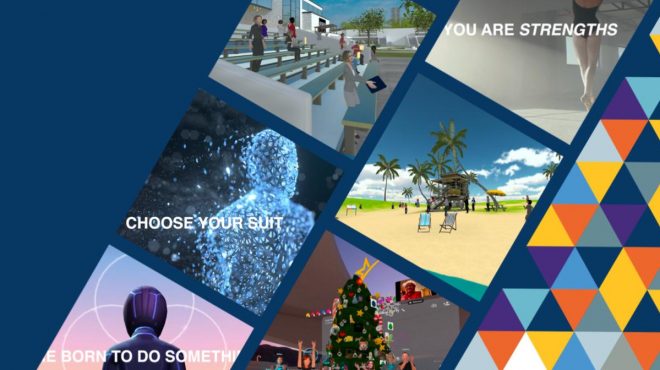ETIP #297
How to Engage Employees & Recruit Talent Using the Metaverse

The hiring process is broken. Too many good candidates are getting overlooked for the wrong reasons and compatible career matches are dwindling. The problem? No concrete data. In our third webinar session of the four-part series, “Ways to Prepare Your Business for Web3 and the Metaverse,” we chatted with Scoutible founder and CEO, Angela Antony, and Starmark’s Chief Digital Officer, Brett Circe, to learn more about talent recruitment and employee engagement in the Metaverse. Here’s what we discovered:
What’s Scoutible?
Angela Antony was looking for ways to improve the hiring game, so she invented her company, Scoutible; an innovative platform that uses award-winning gaming technology and data (developed by Harvard and Stanford scientists) to help people identify their professional skills, styles, strengths and passions in an engaging, accurate way. Once discovered, skills are used to empower candidates to find the right job for them and vice versa — all regardless of educational backgrounds or prior work experiences. Scoutible’s Meta world is currently in beta and we can’t wait to see where it goes next.
Beyond the Resume
According to Antony, “By creating a gamified solution, we can harvest the soft skills that matter most in the Metaverse and create real-life opportunities.” The game measures a candidate’s strengths and weaknesses to understand their professional styles. This way, everyone is seen for their strengths. Based on a resume alone, certain people would not have even been brought to the table. But thanks to Scoutible, they have been found as top performers in their field. Now, candidates can be hired for their skill sets over anything else.
A New Form of Head Hunting
Scoutible is also working to find people that fit the employer’s profile at a lower cost due to its accuracy and efficiency. For example, over 900 applications were placed for an engineering position, but there was one leading applicant over hundreds of Ivy leaguers: a full-time auto mechanic that taught themselves to code at night. This person may have easily been overlooked in a traditional hiring process. Antony makes an interesting point in that the employer or the prospective employee makes the decision for the job in the first ten seconds, meaning that first impressions are incredibly impactful. So, from a diversity, inclusion and belonging standpoint, the Metaverse really eliminates unconscious bias, as well as geographical barriers with its digital representation of the professional world. This enables companies to hire candidates based on their strengths instead of locations or resumes.
VR Brought the Culture Back
COVID-19 posed massive challenges to businesses world-wide. How will companies maintain a team when everyone is remote? Can coworkers really connect through Zoom? Brett Circe’s Starmark decided to roll with the punches and face the issues head-on — literally. They sent all employees (AKA Starmarkers) Oculus Quest 2 headsets. How did they train up their staff? By having them attend a virtual holiday tree trimming party dedicated to teaching them how to use VR. Brett recounted that the holidays are a great time to bring coworkers together to connect and unwind in fun and festive virtual environments — each that were a surprise to the teams every time. Thanks to holiday parties, happy hours, and hangouts in VR, Starmark’s culture was able to make the comeback it needed to post-pandemic.
VIRTUAL COLLABORATION
Of course the Metaverse has its advantages and disadvantages, but Circe finds that when employees wear the headset, they are fully immersed in meetings — without email, text or chat distractions. Starmark practices Agile Methodology, which heavily emphasizes individual interactions and collaboration over products and tools, and VR is the perfect place to gather for their “sprint retrospectives.” These “retros” are where teams celebrate their accomplishments, and debrief on their most recent sprint (the last two week’s worth of work). Upon going remote, each retro meeting has been held in different VR environments that generate more conversation and better focus than other virtual predecessors like Zoom or Google Hangouts. Starmarkers are finding collaborative projects in the metaverse to be increasingly fruitful, productive and as a bonus, downright fun — as long as you keep a straw nearby to hydrate.
Want to learn more about the Metaverse and Web3? Check out our full series, Ways to Prepare Your Business for Web3 and the Metaverse, for tips on how to market your business holistically in a virtual world.
